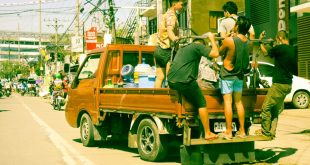Student debt is the second largest form of consumer credit, next to mortgages, and today, more than 45 million people owe nearly $1.7 trillion. Every 26 seconds, one of those student loan borrowers defaults on their loan. The effect is not just that people can spend their whole lives deeply in debt, sometimes into old age, but that it generates further economic, gender, and racial inequality in our society.
Over the last few years, the Biden Administration has tried to ease and expand on student debt forgiveness programs launched under the Obama administration, achieving some success in the process, but continuously facing legal challenges from Republican states that have halted an extensive program unveiled in 2021 and threaten to do the same with one released last year.
In the meantime, borrowers still have options if they are low-income, have paid up for a decade or two, or have worked on public service jobs, but the loan servicing panorama is complex and plagued by lax regulations and bad actors.
A panel of experts hosted by Ethnic Media Services explained what programs are still on the books, which ones have been stopped or threatened, and the future avenues for college affordability and equity.
Adam Minsky, student loan lawyer and author, offered an in-depth look at the Biden administration’s efforts to alleviate the burden of student loans. Amidst the ongoing debates and legal challenges, the administration has been navigating a complex landscape to bring financial relief to millions of Americans.
The initial broad relief effort proposed by the administration aimed to cancel up to $20,000 per borrower, which could have impacted millions. However, this plan was ultimately struck down by the Supreme Court in a 6-3 decision, citing overreach under the HEROES Act of 2003, which did not explicitly authorize mass debt forgiveness.
Despite this setback, the Biden administration has successfully implemented other initiatives, leading to the forgiveness of approximately $153 billion in student debt for around 4.3 million borrowers. Among the significant moves was the IDR Account Adjustment, a temporary waiver allowing borrowers to count previous payments towards forgiveness more generously, which has already enabled close to a million borrowers to qualify for loan cancellation.
Furthermore, reforms in the Public Service Loan Forgiveness (PSLF) program have dramatically increased approval rates. From a staggering 99% rejection rate in 2020, the program has seen approvals soar to nearly 900,000 by last month, marking a drastic improvement in its execution.
Adding to these efforts, the administration has introduced new pathways under the Higher Education Act for broader debt relief, which includes provisions for borrowers affected by runaway interest, long-term forbearances, and those misled by low-value educational programs.
Another significant development is the introduction of the SAVE Plan, touted as the most affordable income-driven repayment plan yet. This plan aims to provide substantial relief, especially to those with lower incomes and smaller debt amounts, by offering a forgiveness timeline as short as 10 years for some borrowers.
As these programs unfold, they are not without challenges. Several are currently facing legal scrutiny, and new lawsuits could shape the future landscape of federal student loan forgiveness. However, the ongoing implementation of these programs signals a robust attempt by the Biden administration to address the persistent issue of student debt in America, offering a glimmer of hope to millions burdened by educational loans.
Michele Shepard Zampini, TICAS Senior Director of College Affordability Virginia Brown, a mental health counselor and social worker who just retired and was able to move closer to her family thanks to debt forgiveness, provided a stark contrast to the earlier technical breakdown of existing policies, focusing instead on the borrowers’ experiences and the broader societal impacts, particularly for communities of color.
Shepherd began by acknowledging the profound effect of the pandemic-induced payment pause, which suspended federal student loan payments from March 2020 until the fall of the subsequent year. This pause served as a critical financial lifeline for tens of millions of borrowers, allowing families that were previously burdened by debt a measure of financial relief they hadn’t experienced in years.
However, the transition back to repayment has been fraught with challenges. The shift has introduced significant confusion among borrowers about their eligibility for forgiveness and the status of their loans—confusion compounded by the Supreme Court’s rejection of a major debt cancellation effort. Shepherd pointed out that borrowers are receiving mixed messages about the availability and terms of forgiveness, contributing to widespread uncertainty and anxiety.
Amidst these challenges, Shepherd highlighted the Biden administration’s efforts to introduce measures like the SAVE Plan, which aims to make loan repayments more affordable. Although not a direct loan forgiveness measure, the SAVE Plan is designed to ease the burden on borrowers by reducing monthly payments and, importantly, covering unpaid interest on loans, preventing debt from growing unmanageably.
She also addressed the systemic issues contributing to the burgeoning student debt crisis. She noted a significant shift over the past decades from publicly funded education to a model where families bear the majority of higher education costs. This shift has disproportionately affected students of color and those from lower-income backgrounds, exacerbating the challenges of access to higher education.
As the discussion shifted to the broader implications of these policies, Shepherds underscored the need for a comprehensive approach to education funding that reduces reliance on debt. She advocated for a system that supports students through grants rather than loans, thereby mitigating the cycle of debt that ensnares many families.
The conversation highlighted a critical crossroads for student loan policy in America. As the Biden administration navigates legal and political hurdles to provide relief, the overarching goal remains clear: to alleviate the burden of student loans in a way that addresses both immediate needs and long-term systemic issues. Only through such comprehensive measures can true equity in education financing be achieved, ensuring all students have access to the opportunities that higher education affords without the crippling burden of debt.






